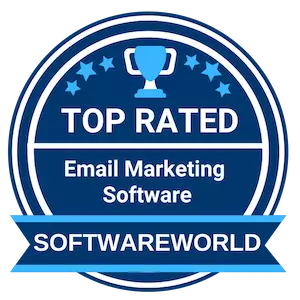How to Make Email Marketing and Social Media Go Hand in Hand ?
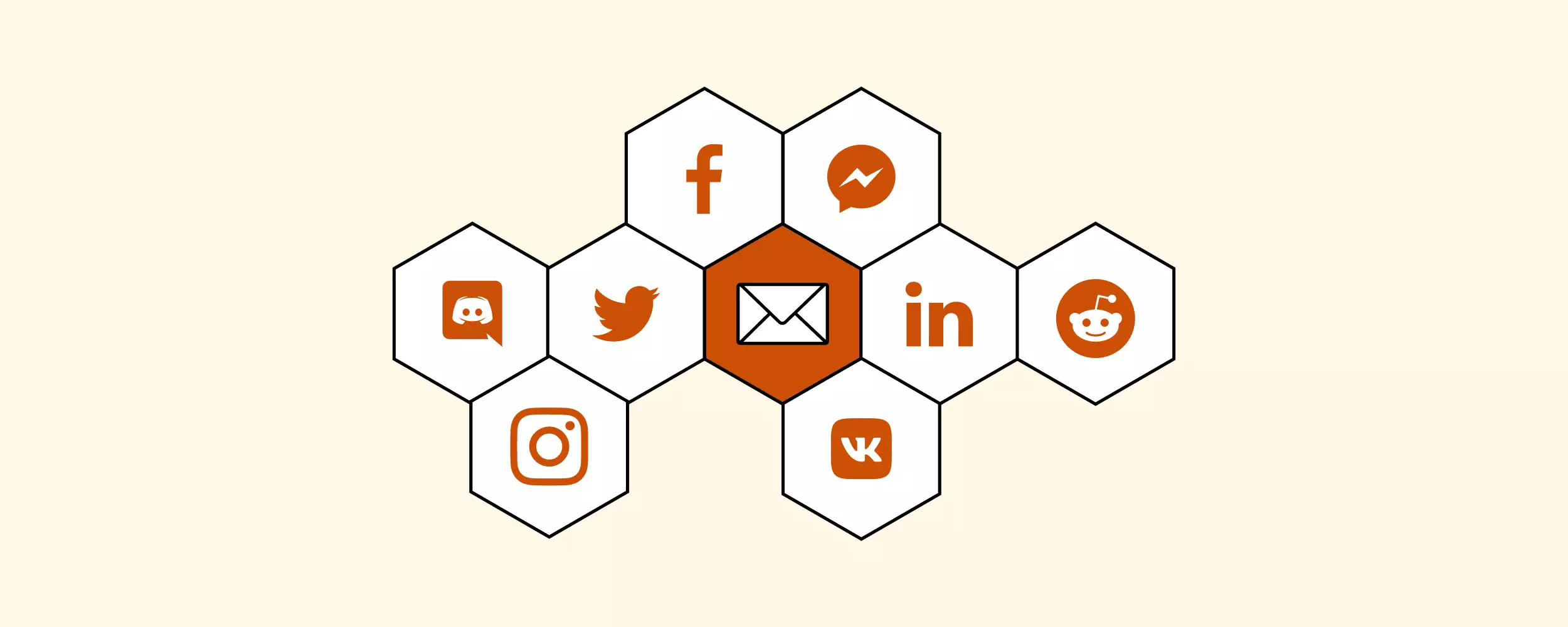
Have you ever heard anyone say that email is dead? Or maybe you were encouraged to abandon social channels because algorithms are "hiding your posts"?
Instead of arguing for or against, let's turn to the data. According to Statista, email usage has been growing continuously, and both email and social media are among the main forms of content marketing today.
There's no reason to give up on any of these marketing types. Instead, you can learn more about each of them and think of email and social media as complementary elements that help you grow your reach and sales.
In this article, you'll learn about the specifics of email and social media marketing and tactics you can utilize right away to make email work for your social media and the other way around.
Email Marketing and Social Media: Should You Pick Either or Both?
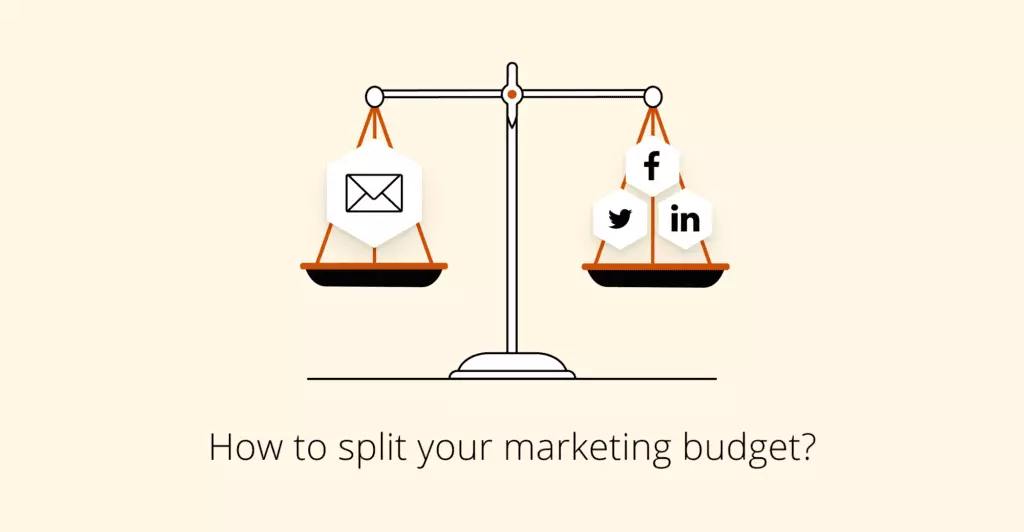
To learn more about the complementary power of email marketing and social media, you need to understand the differences, strengths, and weaknesses of the two. Here it is all summed up.
Number of Accounts
If your brand is on social media, chances are that you're not using solely Instagram or Facebook; you're probably on at least a couple of other platforms too.
When it comes to email, it's usually that you either manage just one account or more than a single person can handle ?
Dealing with multiple accounts can be genuinely overwhelming; that's why it's crucial to get yourself a solution that will gather interactions coming from different platforms in one place. This can save you from getting lost among all these notifications. You can try Mailbird for emails and a social media engagement tool from NapoleonCat for your social media interactions.
Expected ROI and Costs
According to DMA, for every dollar you spend on email marketing, the average expected ROI accounts for $42. But when it comes to measuring social media ROI, marketers often find it troublesome.
That's because social media marketing is more than posting; to use social media to its full potential, brands create campaigns and engage with their followers. They build relationships, which takes time and usually does not result in instant, trackable sales. Due to the scope of work, external social media marketing agency is often hired, which adds to the cost.
Obviously, you can measure conversions using Google Analytics, but most importantly, it's crucial to understand the goal of your social media efforts and adjust the rates you measure accordingly.
You can track your engagement rates, which seems reasonable if you use social media for user engagement. You can also track clicks if you use social media to drive traffic to your website. If you aim to increase exposure and develop a fan base, it's best to measure reach and followers' growth.
Audience Engagement
Social media is a natural habitat for interaction. When you post, people react to your publication, comment, and sometimes even share or retweet your content. But when you send email newsletters, you rarely hear from the other side. If you reach out to people individually using mass email services, it's also challenging to get an answer.
What is the reason behind it?
Social media is informal and casual in its nature. Commenting doesn't oblige you to do anything; it's like having a friendly chat.
Replying to an email resembles official communication. People don't usually reply to your email to compliment your witty copy; rather, they go straight to the point and start talking about business or purchases.
Does this mean emails are no good for building engagement?
Not an inch. It's just a different kind of engagement. You can use CTAs and encourage people to check your blog content or use a discount code while shopping.
Simply put: social engagement is about encouraging interaction, while email engagement is about encouraging action.
Frequency of Posting
Frequency is one of the deciding factors for growing reach on social media. For example, Instagram displays the best content published since your last visit.
Additionally, it's followers who choose how much content they want to consume - if they don't want to hear from their social media community, they simply don't open the app. If you don't feel like scrolling anymore, you just stop scrolling.
It's a bit different with emails; you check your inbox regularly and take action on almost every message, whether by replying or deleting it. But the chance you'll miss something is much lower.
These characteristics may lead you to conclude that it's best to send emails as frequently as possible, but there's one more factor you should consider: human nature.
People are overwhelmed with the number of emails they receive; they're literally snowed under. That's why contacting them too frequently may trigger delete reflexes.
Try to establish a happy medium - the ideal frequency of messages to truly reach your audience with your content.
According to Statista, most consumers would like to receive emails from their favorite retailers once a week. In the case of telecom providers, most consumers say they'd prefer to get email notifications just once a month. Test different frequencies and try to figure out what would be best for your niche and, specifically, your brand.
Audience Segmentation
Audience segmentation allows you to target customers based on unique characteristics and increase the effectiveness of your marketing campaigns.
For your email campaigns, you can divide your subscribers into smaller segments based on any data you have, e.g., user location, interests, or purchase history. Some of these data should be available right from the moment of registration (e.g., location); other metrics are gathered along the way.
Having all this information and delivering content relevant to a specific group of recipients ensures better open and click rates for your emails; it also positively influences your sales. You can then check email marketing statistics to adjust your emails for better results
For your social media strategy, monitoring your followers' demographics and activity trends allows you to tailor your content's aesthetics, tone, and posting schedule to align with their preferences. Businesses and creators can leverage Instagram Insights for in-depth analytics on their Instagram accounts. Additionally, with Instagram desktop app access through Mailbird, managing your presence and understanding audience engagement becomes more streamlined, just as utilizing Twitter dashboards enhances your strategy on that platform.
You can also create custom audiences and target your sponsored social media content to specific audiences, not necessarily your followers. That's how you reach new audiences from your target market.
Should You Pick One or Both?
As you can see, email and social media marketing aren't two channels that can be replaced with one another. Contrarily, they can be used for achieving different goals and, if used properly, can mutually support their effectiveness.
If you wish to successfully reach people with your message, you shouldn't pick one over the other but instead use emails to complement your social media efforts and vice versa.
Best Practices for Combining Email Marketing and Social Media

With all these fundamental differences in mind, you can start making both email and social media marketing work better. Here's what to do:
#1: Reuse Content
Producing large volumes of content for emails and social media can be challenging. But you can help yourself and reuse content.
By sending the same message across different channels, you will grow your reach. Remember that some audience members may be subscribed to your email list or follow you on socials but not necessarily both - and they might miss out on that content.
You don't need to reinvent the wheel; take the content you've already prepared for your email campaign and simply adjust it to the specifics of social media.
#2: Find Inspiration for Your Content
Having conversations with your audience on social media can give you inspiration for content.
Ask your social media audience about their problems and difficulties. Gather their answers and address their needs in your upcoming social media posts and newsletters.
Pay special attention to the words your audience uses, and create your copy with the very same words. Speak their language.
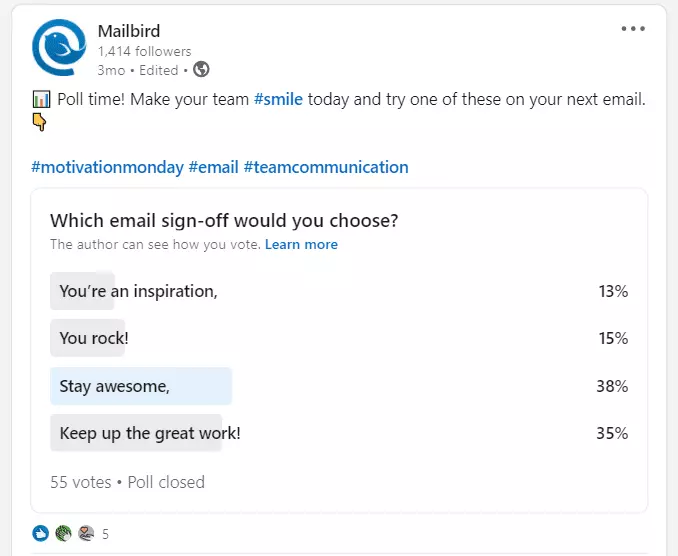
#3: Follow Your Mailing List
Following your mailing list on social media is a great way to learn more about your audience, establish relationships, and increase engagement. Here's how you can do this:
Upload your subscribers' email addresses into a custom audience on your social media channels. These addresses are typically linked to their social profiles. On Facebook and Twitter, you can customize your audience by uploading the email list in the form of CSV or TXT files.
Once your Custom Audience is ready, you can proceed and follow these users or target them with your ads. Targeting your email list with your social media ads is particularly effective since you know that these people are interested in your brand, products, and services.
#4: Grow Your Mailing List
Your social channels are perfect for promoting your newsletters. You can encourage your social media followers to sign up to your mailing list by posting sneak peeks of what you will send in your upcoming newsletter. Here's how Morning Brew created a custom landing page for their Instagram:
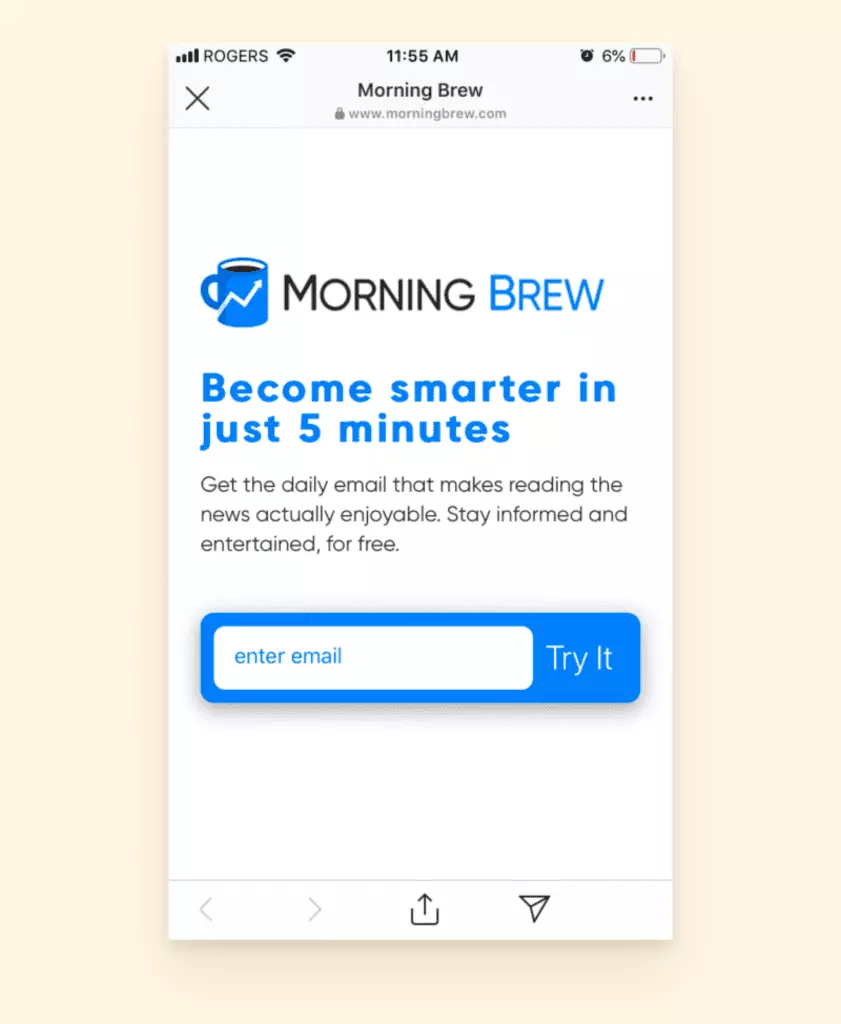
Another important factor is to assure your followers about the exclusivity of your newsletters. In the end, why would they subscribe to your mailing list if your newsletters carry the same content you post on your social media?
What is more, you can also analyze your social media following to understand your potential customers better and therefore create targeted email marketing campaigns. When you send the right offers to the right leads, you can get better results.
If you target other businesses (B2B), you can use multiple techniques to grow your list with LinkedIn. There are several LinkedIn automation tools that help you not only post links to your landing pages on LinkedIn in the feed, but also through direct messages. Some of these tools will also help you find the email addresses of your connections.
#5: Promote Social Media through Emails
So you now know how to grow your mailing list thanks to social media. However, it also works the other way around. By promoting your social channels in your emails, you can gain new followers and build trust.
The simplest yet most effective step you can take is to add social media buttons to your newsletter's footnote or email signature, note the Instagram icon here:
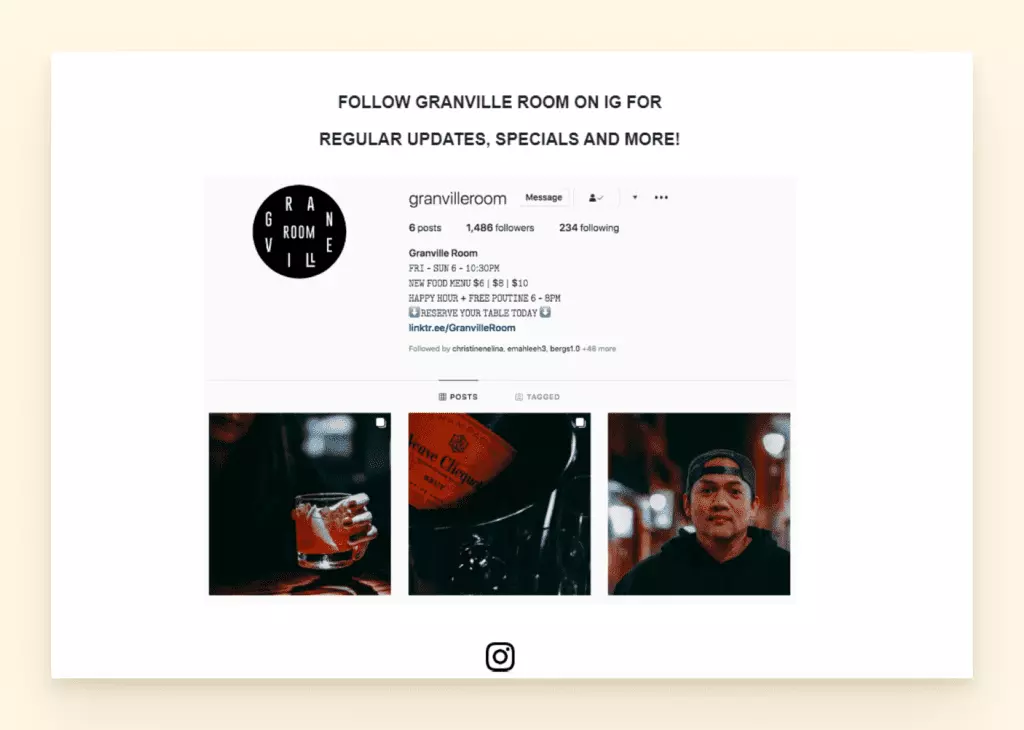
Another great way to drive traffic to your social media is by adding CTAs for joining you on social media; here's an example from a shoe brand, Alohas, which invited their audience to join them on Instagram Lives:
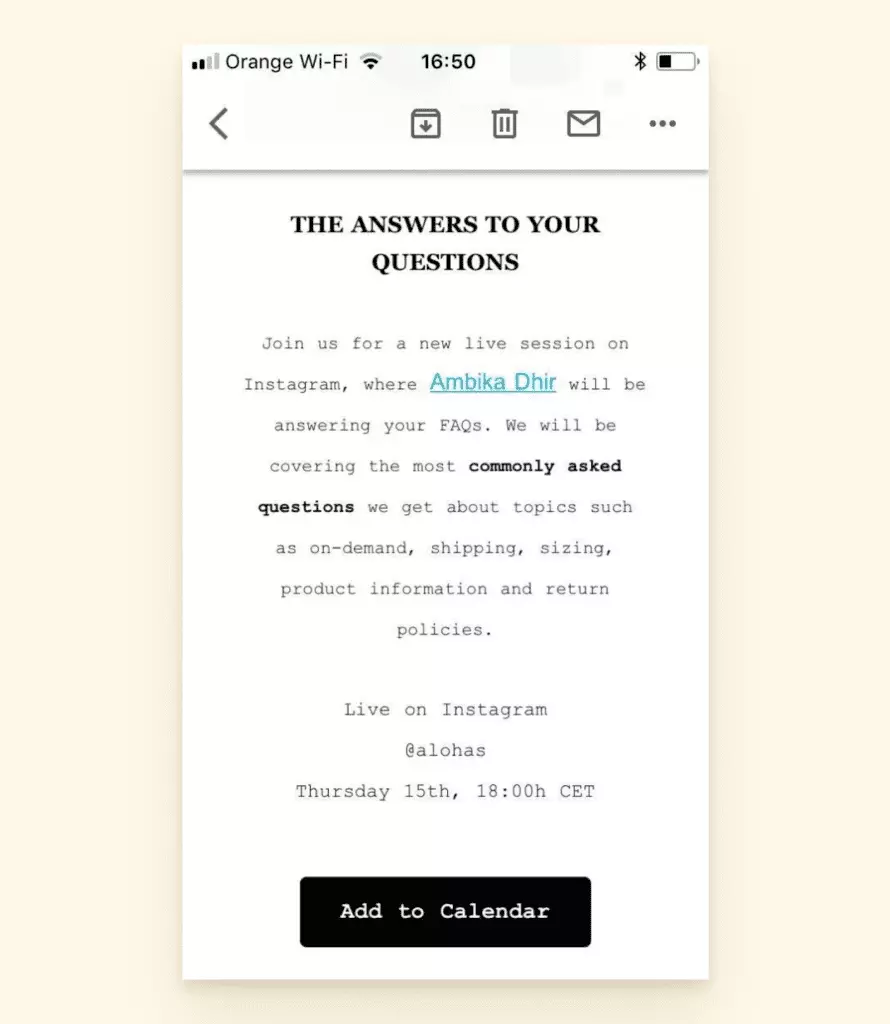
You can also send an email to your subscribers and describe why they should follow you on social media. One idea is to promote a hashtag, encourage your audience to use it, and show examples of what has already been posted under the hashtag.
#6: Improve the Outreach Process
As we've already established, social media is perfect for building relationships and trust. But if these two are already established, and you're on the right path to sell something to your prospects, it's best to redirect the conversation to an official space, AKA emails.
In this way, you can build a kind of funnel: you start conversations (customer acquisition) on social media and redirect users to email to discuss details. You can learn more about acquiring clients on socials from Nico Prins.
If you're actively reaching out to prospects on social media, consider using a single inbox that gathers all social media interactions in one place. In this way, you can be sure nothing escapes your attention. And NapoleonCat can help you with that. Furthermore, you can unify all your tasks and emails too, as that's what Mailbird can help you with.
Wrap up
Taking care of your email and social media marketing can be a handful, but it's crucial to use these two communication channels to achieve your goals. Social media will help you build engaged communities and develop trust towards your brand, but if you wish to grow your sales, email marketing is your top choice. If you want to work smart, follow our best practices and use email and social media as complementary channels that improve the overall effectiveness of your marketing efforts.
Managing how you communicate with both your team and your customers must be considered if you want to run successful campaigns via either channel. Mailbird will enable you to streamline your messages into one place. You'll also have the advantage of quickly updating calendars, contacts, and project notes all from one app. Give it a try and notice how quickly you'll spend less time worrying about missed threads or updates.
